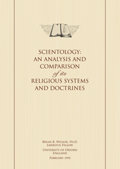ii.i. The Principal Characteristics of Religion
In accordance with the foregoing considerations, we may now indicate, in abstract and general terms, the principal characteristics of religion. What follows does not purport to be a universally applicable definition so much as the enumeration of features and functions which are frequently found in religion, and which are identified as such. These are:
(a) belief in an agency (or agencies) which transcend(s) normal sense perception and which may even include an entire postulated order of being;
(b) belief that such an agency not only affects the natural world and the social order, but operates directly upon it and may even have created it;
(c) the belief that at some times in the past explicit supernatural intervention in human affairs has occurred;
(d) supernatural agencies are held to have superintended human history and destiny: when these agencies are anthropomorphically depicted they are usually credited with definite purposes;
(e) the belief is maintained that man’s fortune in this life and in afterlife (or lives) depends on relationships established with, or in accordance with, these transcendental agencies;
(f) it is often (but not invariably) believed that whilst transcendent agencies may arbitrarily dictate an individual’s destiny, the individual may, by behaving in prescribed ways, influence his experience either in this life or in future life (lives) or both;
(g) there are prescribed actions for individual, collective or representative performances—namely, rituals;
(h) elements of placatory action persist (even in advanced religions) by which individuals or groups may supplicate for special assistance from supernatural sources;
(i) expressions of devotion, gratitude, obeisance or obedience are offered by, or in some cases, are required of believers, usually in the presence of symbolic representations of the supernatural agency(ies) of the faith;
(j) language, objects, places, edifices, or seasons that are particularly identified with the supernatural become sacralized and may themselves become objects of reverence;
(k) there are regular performances of ritual or exposition, expressions of devotion, celebration, fasting, collective penance, pilgrimage and reenactments or commemorations of episodes in the earthly life of deities, prophets or great teachers;
(l) occasions of worship and exposition of teachings produce the experience of a sense of community and relationships of goodwill, fellowship and common identity;
(m) moral rules are often enjoined upon believers, although the area of their concern varies: they may be couched in legalistic and ritualistic terms, or they may be canvassed more as conformity with the spirit of a less specific, higher ethic;
(n) seriousness of purpose, sustained commitment and lifelong devotion are normative requirements;
(o) according to their performance, believers accumulate merit or demerit to which a moral economy of reward and punishment is attached. The precise nexus between action and consequence varies from automatic effects from given causes to the belief that personal demerit may be cancelled by devotional and ritual acts, by confession and repentance, or by special intercession from supernatural agents;
(p) there is usually a special class of religious functionaries who serve as custodians of sacred objects, scriptures, and places; specialists in doctrine, ritual and pastoral guidance;
(q) such specialists are usually paid for their services, whether by tribute, reward for specific services, or by instituted stipend;
(r) when specialists devote themselves to the systematization of doctrine, the claim is regularly made that religious knowledge provides solutions for all problems, and explains the meaning and purpose of life, often including purported explanations of the origin and operation of the physical universe and of human psychology;
(s) legitimacy is claimed for religious knowledge and institutions by reference to revelation and tradition: innovation is regularly justified as restoration; and
(t) claims to the truth of teaching and efficacy of ritual are not subjected to empirical test, since goals are ultimately transcendent and faith is demanded both for goals and for the arbitrary means recommended for their attainment.
The foregoing items are not to be regarded as sine qua non, but as probabilities: they constitute phenomena frequently found empirically. It may be regarded as a probabilistic inventory.
II.II. Non-Essential Characteristics of Religion
The foregoing inventory is set forth in terms of considerably abstract generalization, but actual religions are historical entities, not logical constructs. They encompass widely different organizing principles, codes of conduct and patterns of belief. At many points, generalization is not easy, and once the (often unconscious) prejudices of the Christian tradition are set aside, it becomes apparent that many of the concrete items which, on the basis of the Christian model, might be supposed to be the sine qua non of religion, are, in fact, not found in other systems. In the foregoing inventory, allusion to a supreme being is avoided, since for Theravada Buddhists (and for many Mahayana Buddhists), Jains and Taoists that concept has no validity. Worship, referred to above, has very different implications in Buddhism from those which it carries for worshippers in Christianity. The inventory makes no reference to creeds, which are of peculiar importance in the Christian tradition, but are not of such importance in other religions. It does not mention the soul, vital as is that concept in orthodox Christianity, because the doctrine of the soul is somewhat dubious in Judaism, and is explicitly denied by some Christian movements (e.g., the Seventh-day Adventists and Jehovah’s Witnesses—each of which bodies has millions of adherents throughout the world, and by Christadelphians and those Puritans, including Milton, who were known as moralists). There is no direct reference to hell in any sense of the idea developed in Christianity, since this item is lacking in Judaism. The afterlife is alluded to in the singular or the plural to accommodate the two variant Christian ideas of transmigration of the soul and of the resurrection, and the somewhat different accounts of reincarnation in Buddhism and Hinduism. None of these specific items can be considered essential to the definition of religion tout court.





























